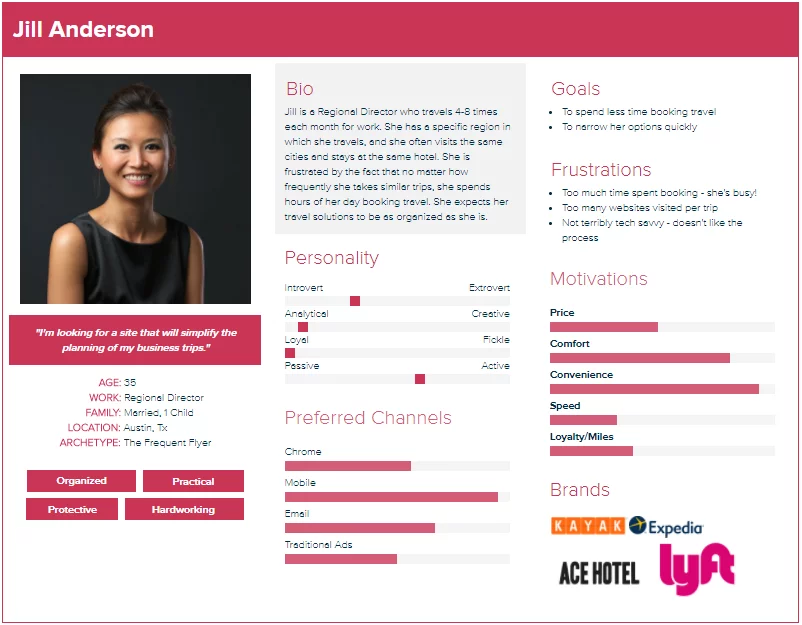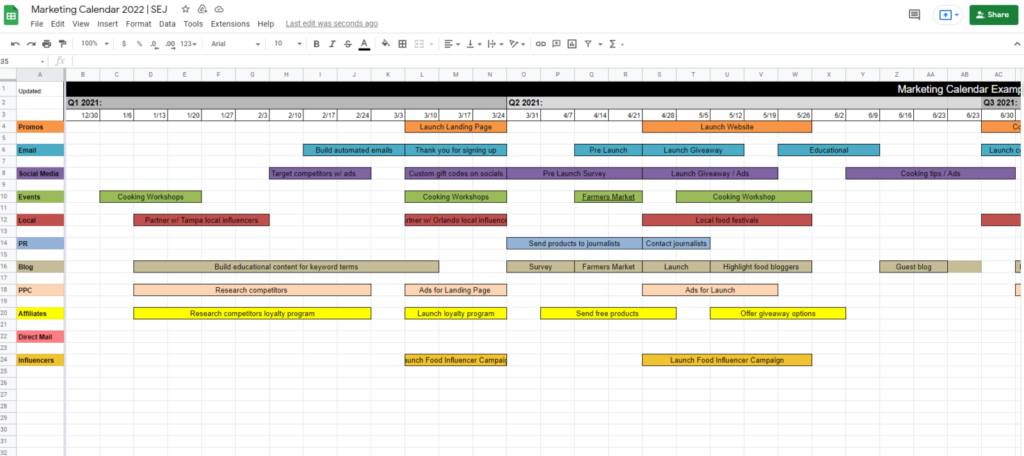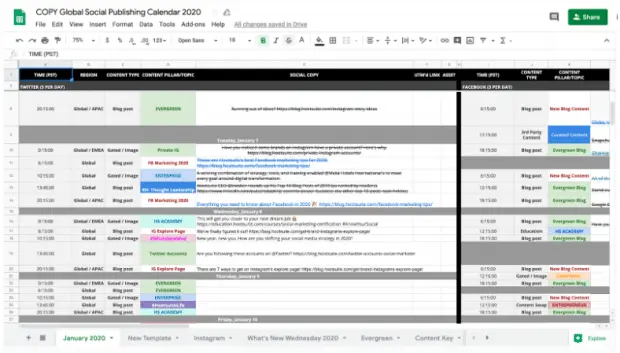Marketers, let’s chat about your 2022 marketing strategy. Ideally, you’d already have this completed—but if you don’t, don’t stress! It’s not too late and we’re here to help. We’ve outlined step-by-step what to consider as you create a robust marketing plan to support your organization’s overall goals and its products and services.
Step 1: Set Your Goals
The first step of your 2022 marketing strategy is to define your goals—both at a high level and tactically. To do this, you need to have a clear understanding of your organization’s mission, sales objectives, priorities, and revenue targets.
Step 2: Determine Key Performance Indicators
Key performance indicators (or KPIs for short) are the total output of your marketing campaigns. What do you want to achieve with your marketing? The key here is to make it measurable (and realistic, of course). Take a look at last year’s numbers. Also take a look at industry benchmarks. This will help you to set realistic expectations. Try to put KPIs in place for each facet of your marketing. Our friends at HubSpot have a great list to pull from—here are a few examples:
- Customer Acquisition Cost (CAC): The money it takes to acquire a new customer. This KPI ensures your spend to convert a prospect isn’t more than your profit.
- Customer Lifetime Value (LTV): The LTV metric highlights how much money a business can expect the average customer to spend. Comparing this to CAC above helps ensure you’re profitable. Also, analyzing your LTV can help you understand how to increase it over time.
- Return on Investment (ROI): Revenue generated above and beyond your campaign spend.
- Marketing Qualified Lead (MQL)/Sales Qualified Lead (SQL): Understanding how many leads marketing brings in (MQL) helps validate your efforts. Once ready to talk to sales, they’re considered a SQL.
- Organic Traffic: Your blog’s purpose is to boost awareness and attract inbound leads. The main measurement of this is through organic traffic. Using a combination of web analytics and SEO tools, you can understand exactly which blogs and keywords are bringing in the most traffic. From there, you can strategize on how to capitalize even further.
- Follower/Subscriber Growth: Keep track of how your blog, social, and email subscribers have grown over the past year to gauge success of your efforts.
- Conversion Rate: Simply put, this is the % of visitors who completed an action—content download, email subscription, etc. This will give you a good indication on how you’re converting leads.
Step 3: Positioning
Once you have clearly established goals in place, it’s time to take a look at your product offering and positioning. You can have the best marketing strategy in the world, but it’s not going to be successful if it’s not aligned with your target audience. That’s where doing a customer and competitor analysis come into play:
Customer Analysis/Persona Development: Each year, do a deep dive into your customer data to make sure you understand their constantly evolving interests, motivations, behavior, and more. This research helps to iterate on your previously defined personas so that you can be sure you reach your intended audience effectively. Having access to a powerful social audience insights tool will help you understand and prepare for these changes in real time.

Looking for a deep dive into persona building? Check this out.
Competitor Analysis: Once you’re done with your target audience gut check, it’s time to take a look at your competitors. What are they up to? Has their positioning changed? Any new competitors to add to your list? Take a look at their marketing and get a feel for what they’re doing and how you can level up to ensure you’re one step ahead of them.
Now that you’ve created or validated your buyer personas and conducted a comprehensive competitor analysis, you’re set up to better inform product positioning and messaging so that it will not only resonate and attract your key buyers, but differentiate your product offering from your competitors.
Step 4: Let’s Get Tactical
Your goals are set, your KPIs are in place, and you’ve crafted messaging that will stand out to your buyers. Now it’s time to actually develop your marketing strategy as well as all additional marketing support for cross organizational initiatives. This includes what marketing channels you’ll utilize, which these days is vast. Here are just a few channels from print and digital to in-person experiences that marketers have at their fingertips to reach their intended audience:
- Print
- Magazines and newspapers
- Direct mail
- Digital
- Paid search
- Online publications
- Social media
- Events
- In-store experiences
- Tradeshows and conferences
- Webinars
- Broadcasting
- Podcasts
- Radio
- Streaming service
Marketers have so many channels to choose from, it can be overwhelming. By truly understanding your audience (cue those personas), the channels they are engaging on, and where they are in your customer lifecycle, will help you refine and select the best channels to reach them. Your budget will also largely dictate what you can do, so prioritize based on where you can get the highest return on investment.
If you’re part of a broader marketing team, each person should play their respective role. Here is a very rough hierarchy of what that means:
- Product Marketing
- Positioning/messaging
- Product launches
- Product updates
- Product landing page optimization
- Marketing Communications
- Press releases
- Email marketing
- Demand Generation
- Content Marketing (organic): blog, eBooks, video, podcasts, webinars, social media, etc.
- Paid media: inline, print, radio, social, etc.
- Website: content, UI and UX
- Events: trade shows, conferences, speaking engagements, etc.
Step 5: Get Organized
Now that you have your marketing tactics established for each campaign, it’s important to make sure all the marketing activities are outlined, including timelines, roles and responsibilities, and budget. Here are two examples of how you can organize your marketing plan:
Example #1: Create a master Marketing Calendar in Google docs outlining campaigns by quarter and by month:

Example #2: Create a Marketing Calendar with tabs that drill down into the monthly campaigns for each initiative (product, content, etc.). Here’s an example of a Content Calendar:

Step 6: Data & Reporting
Remember those goals we set-up in step 1? Here’s how we determine if we’re hitting them so that you can justify future spend and budget accordingly. The final step in your marketing plan is having the right tools in place to measure the success of your campaigns. Data should drive every decision you make, and it should be easily accessible to your entire marketing team. Below is a high-level overview of the data tools needed to understand how your campaigns are performing and a few popular tools from each category:
- Web analytics tools
- Marketing automation tools (choose 1)
- Content/social analytics tools
Step 7: Revisit & Revamp
The above is everything you need to know to create a successful marketing plan in 2022. But here’s a pro-tip for you—it’s all about iteration. Similar to your new year’s resolutions (oh yes, i went there), your marketing plan needs to evolve throughout the year based on performance and overall objectives. So revisit and revamp often.
We’ll leave you with one last parting gift. A comprehensive list of marketing planning resources to help you get started (if you haven’t already):
- Marketing Plan Templates:
- 2022 Marketing Calendar [Search Engine Journal]
- How To Create A Social Media Calendar [HootSuite]
- 6 Marketing Calendar Templates You’ll Actually Want To Use [ContentCal]
- 40 Marketing Plan Samples And Examples [CoSchedule]
- Ultimate Marketing Technology Stack For 2022 [Intercom]
- Data & Reporting Resources:
- How Social Insights Transforms Marketing Strategies [StatSocial]
- Marketing KPI Template in Google Sheets [SheetGo]
- Marketing Dashboard for Excel & Google Sheets [HubSpot]
- The 10 Marketing KPIs You Should Be Tracking [IMPACT]
- 2022 Marketing Trends:
What are some goals you have for your marketing campaigns this year? Comment below.